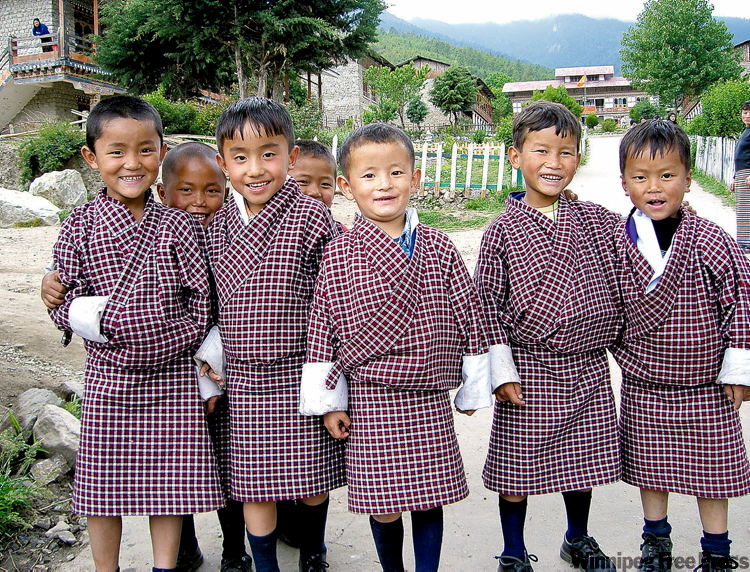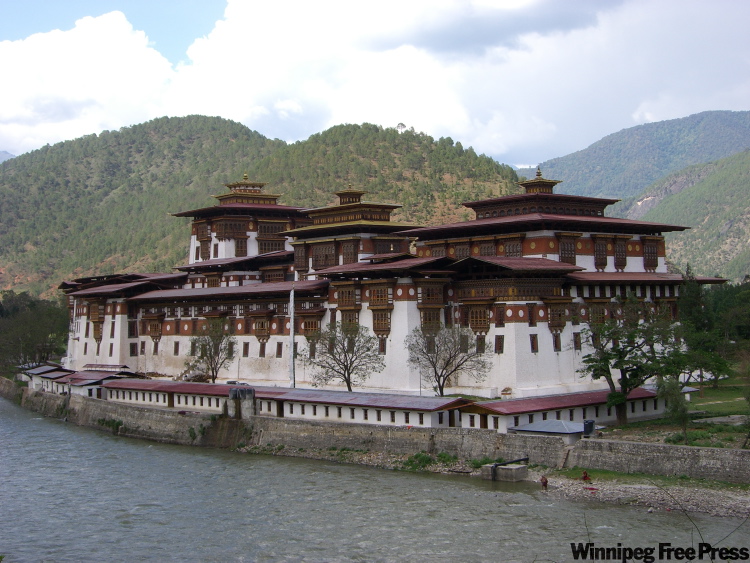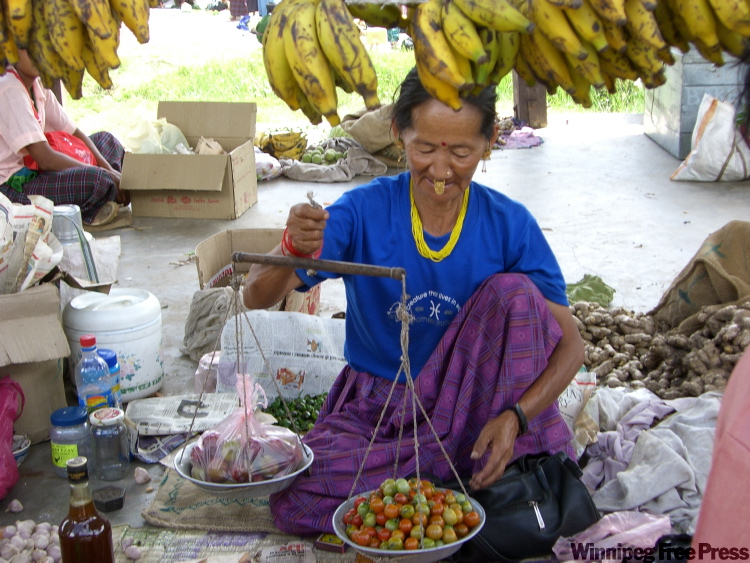Spectacular Bhutan opens colourful, unique past to lucky few
Advertisement
Read this article for free:
or
Already have an account? Log in here »
To continue reading, please subscribe:
Monthly Digital Subscription
$1 per week for 24 weeks*
- Enjoy unlimited reading on winnipegfreepress.com
- Read the E-Edition, our digital replica newspaper
- Access News Break, our award-winning app
- Play interactive puzzles
*Billed as $4.00 plus GST every four weeks. After 24 weeks, price increases to the regular rate of $19.00 plus GST every four weeks. Offer available to new and qualified returning subscribers only. Cancel any time.
Monthly Digital Subscription
$4.75/week*
- Enjoy unlimited reading on winnipegfreepress.com
- Read the E-Edition, our digital replica newspaper
- Access News Break, our award-winning app
- Play interactive puzzles
*Billed as $19 plus GST every four weeks. Cancel any time.
To continue reading, please subscribe:
Add Free Press access to your Brandon Sun subscription for only an additional
$1 for the first 4 weeks*
*Your next subscription payment will increase by $1.00 and you will be charged $16.99 plus GST for four weeks. After four weeks, your payment will increase to $23.99 plus GST every four weeks.
Read unlimited articles for free today:
or
Already have an account? Log in here »
Hey there, time traveller!
This article was published 23/01/2010 (5749 days ago), so information in it may no longer be current.
THIMPHU, Bhutan — After passing Mount Everest on the left, the Druk Air Airbus 319 weaves its way down a narrow mountain valley to land at Paro.
The few visitors on board have little idea of what lies ahead: a 15th-century mad monk named Lama Drukpa Kuenley whose phallus is symbolized graphically on buildings to ward off evil spirits and/or promote fertility; a chain of luxurious yet local resorts surrounded by spectacular scenery; muffins with chili; marijuana growing along the road being gathered as pig feed; countless stray dogs, itinerant road-menders breaking stones along the one-lane highways; cliff-hugging monasteries; fortresses; and a benevolent king, who, last year, abdicated in favour of democracy and the Gross National Happiness index.
Welcome to Bhutan, Himalayan mountain kingdom extraordinaire — druk yul, the land of the thunder dragon. Tucked in between Tibet (China) to the north and India on the three other borders, Bhutan has a population of about 690,000. Some two-thirds are subsistence farmers. Eighty per cent live at least an hour’s walk from a road, and about half live more than a day’s walk from a road.

Bhutan opened its doors to tourists only in 1974. Although the annual limit of 2,000 visitors has been lifted, so far, relatively few outsiders visit: It’s still considered a new and exotic destination.
We want to preserve our environment, our culture, said one government official. Bhutan is trying to avoid the uncontrolled tourism that brought undesirable influences to Nepal, a few Himalayan mountain ranges to the west.
So far, the strategy seems to be working. Visitors pay $200 US a day, which includes all accommodation and meals, taxes and entry fees, plus a guide and driver. That tends to keep out backpackers, but is quite reasonable by international travel standards.
Bhutan is not an ordinary place, said the award-winning writer and Himalayan expert Stan Armington, who is based in Kathmandu. It has one foot in the past and one in the future. (Armington’s Lonely Planet Guide, Bhutan, should be required reading for anybody planning to visit the country.)
The unique past, set in spectacular scenery (elevation ranges from 100 metres in the south to peaks topping 7,000 metres in the north) with the prayer wheels, prayer flags and philosophy of the country’s Buddhist religion, is what attracts most visitors.
The government encourages inhabitants to continue wearing traditional clothing every day, and most do. The attire is compulsory in schools and government offices, and on formal occasions. The men wear a gho, a long robe hoisted to the knee and held in place by a woven cloth belt (kera) tied tightly around the waist. Long socks and, usually, modern footwear, complete the outfit.
Women wear a kira, brightly coloured floor-length cloth that wraps around the body over a blouse, plus a short, open, jacket-like garment called a toego. The women wear flip-flops or modern footwear, but occasionally you will see heels showing from under the kiras of some of the more fashion-conscious.
However, you will want to wear good hiking footwear to visit many of the dzongs (fortresses/administration centres) and especially monasteries, such as the famed Taktshang Goemba (Tiger’s Nest) monastery, which clings to the cliffs at an altitude of 2,950 metres — 900 metres above the Paro valley floor, which makes it a four-hour round-trip hike.
At Punakha, an almost subtropical area with bananas, bougainvillea, jacaranda and prickly pear cactus, you walk half an hour through two small villages and fields and along irrigation channels to the Chimi Lhakhang monastery, built by Lama Drukpa Kuenley (1455-1529), the so-called mad monk or divine madman.

He gained notoriety through his outrageous (sexual, humorous, and insulting) behaviour: provoking people to discard their preconceptions about life and religion.
Childless women go to the temple to receive a blessing from the sexually active saint, whose phallus adorns many buildings in the area to protect them from evil spirits and/or as a symbol of fertility. (Stories in Bhutan often have several versions.) Children can attend school, or go to a monastery to learn to become monks or nuns.
Hotel accommodation also comes in several versions, from basic guest houses to the luxurious Amankora. Five recently opened properties ranging from 24 rooms in Paro and 16 in Thimphu, the capital, down to eight each at Punakha (where the main building is a restored 200-year-old farmhouse) and Gangtey, in central Bhutan.
Chilies and cheese form part of the Bhutanese diet; chilies are eaten as a vegetable rather than being used as a spice — although one morning, my muffins were flecked with red chili.
You also notice countless stray dogs, especially in the towns and villages. They often lie on the roads, along with cows. Local people navigate the narrow winding roads with skill and, for a country with Asian/Indian influence, surprisingly good manners and infrequent horn-honking. Peasants gather the marijuana that grows everywhere to feed their pigs.
Itinerant workers from India and Nepal live in very basic shelters along the roads they repair during the day. You often see women breaking stones with sledgehammers to provide road material.
The previous king, 54-year-old Jigme Singye Wangchuck, introduced a constitution and democracy to Bhutan last year — a move that worried many inhabitants who had become used to the benevolent monarchy in place since 1907. He also introduced the concept of a Gross National Happiness (instead of Product) index, to emphasize the importance of quality of life.
The first general election was held in March 2008, and the first joint sitting of the elected parliament in May.

The Druk Phunsum Tsogpa (Bhutan Peace and Happiness Party) won the elections by a landslide against the PDP (Peoples’ Democratic Party).
You can drive into Bhutan from India, but most visitors fly in on the only carrier, Royal Bhutan Airline’s Druk Air, with two fairly new Airbus 319s, from either New Delhi, or, because of better connections for most travellers, from Bangkok via Kolkata. Economy round trip starts at about $788.
Allow plenty of planning time, especially if you plan to visit in spring or fall, which are the festival seasons. Government-controlled Bhutan tourism is still in its infancy, and the bureaucratic wheels move slowly.
Former Calgary Herald Money columnist Mike Grenby is a travel writer who also teaches journalism at Bond University on Australia’s Gold Coast.
–Canwest News Service

